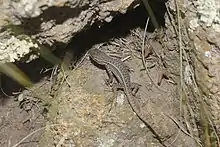| Sceloporus bicanthalis | |
|---|---|
 | |
| Scientific classification | |
| Domain: | Eukaryota |
| Kingdom: | Animalia |
| Phylum: | Chordata |
| Class: | Reptilia |
| Order: | Squamata |
| Suborder: | Iguania |
| Family: | Phrynosomatidae |
| Genus: | Sceloporus |
| Species: | S. bicanthalis |
| Binomial name | |
| Sceloporus bicanthalis Smith, 1937 | |
| Synonyms | |
|
Sceloporus aeneus bicanthalis Smith, 1937 | |
Sceloporus bicanthalis, the trans volcanic bunchgrass lizard, is a species of lizard in the family Phrynosomatidae, first described by Hobart Muir Smith as a subspecies of Sceloporus aeneus in 1937.[2] It is endemic to Mexico.[1][2] It was classified by the IUCN as a species with low risk.[1] No subspecies are recognized.[2]
Description
Sceloporus bicanthalis is a small, viviparous lizard measuring on average 45 mm (1.8 in) in snout–vent length.[2]
Distribution and habitat
Sceloporus bicanthalis ranges eastwards from the eastern Valley of Mexico to the eastern end the Trans-Mexican Volcanic Belt, and into the northern Sierra Madre de Oaxaca.[1]
This species is associated with tussock (bunchgrass) grassland habitats within open pine forests at elevations of 2,900–4,400 m (9,500–14,400 ft) asl.[1]
References
- 1 2 3 4 5 Flores-Villela, O.; Santos-Barrera, G. (2007). "Sceloporus bicanthalis". IUCN Red List of Threatened Species. 2007: e.T64089A12736142. doi:10.2305/IUCN.UK.2007.RLTS.T64089A12736142.en.
- 1 2 3 4 Sceloporus bicanthalis at the Reptarium.cz Reptile Database. Accessed 10 November 2015.
